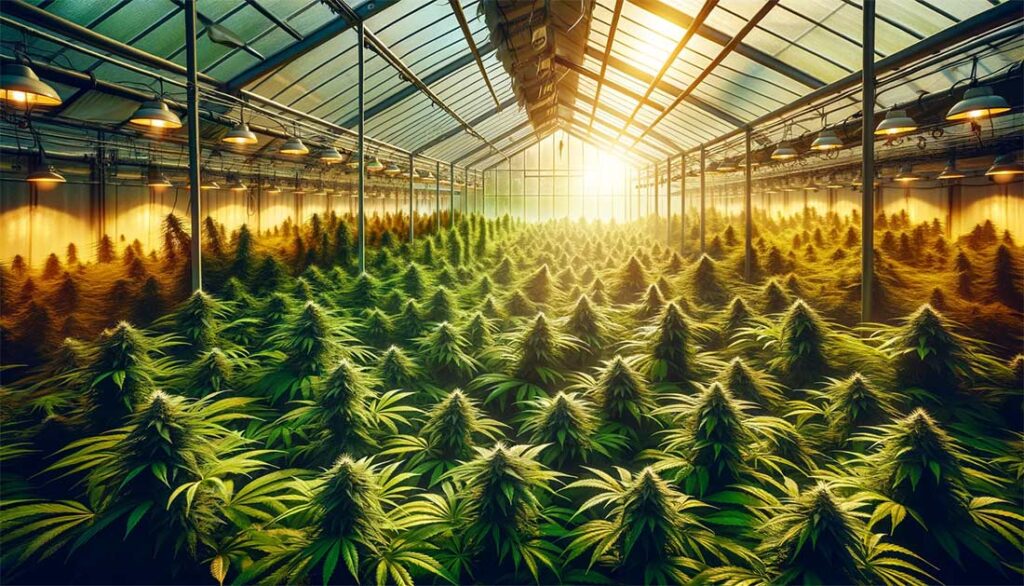Light deprivation cannabis, known simply as “light dep,” is a cultivation technique that manipulates the light cycle of cannabis plants in outdoor setups to induce early flowering. By artificially creating longer nights with light-blocking tarps, growers can mimic the onset of autumn, which cues the cannabis plants to flower. This method surged in popularity in regions like Humboldt County, renowned for its craft cannabis. Originating in the late ’80s, light dep offered a revolutionary way to increase yield by enabling multiple harvests within a single growing season.
Light Dep Weed at a Glance
| Pros of Light Dep Cultivation | Cons of Light Dep Cultivation |
|---|---|
| Increases number of annual harvests | Requires strict scheduling |
| Can improve bud quality and yield | Mistiming can stress plants |
| More economical than full indoor setups | Certain strains may not respond well |
| Environmentally friendly compared to traditional indoor grows | Learning curve for optimal results |
01. The Basic Principle
At its core, the light dep technique is about controlling the amount of light cannabis plants receive. By simulating the shorter daylight periods of autumn, growers coax the plants into the flowering stage earlier than they would under natural conditions.
02. The Strategic Advantage
The strategic advantage of this method is manifold. Not only does it enable growers to harvest multiple times in one season, but it also allows for the cultivation of higher-quality buds with potentially larger yields compared to plants grown without light manipulation.
03. Technological Simplicity
Remarkably, the technology required for light dep is neither complex nor costly. It often involves using tarps or other light-blocking materials to artificially create periods of darkness, typically for 12 hours at a time.
Mechanics of Manipulating Light
01. Timing and Scheduling
The cornerstone of successful light dep is a strict schedule of light and darkness. This usually means 12 hours of light followed by 12 hours of darkness, a cycle that mimics the natural light conditions of late summer to early autumn when cannabis plants naturally begin to flower.
02. The Setup
Setting up a light dep system can vary in complexity from simple manual tarping to more sophisticated automated systems. Growers can implement these techniques in various environments, such as greenhouses, outdoor setups, or even indoors.

The Benefits
01. Multiple Harvests
One of the most appealing aspects of light dep is the ability to increase the number of harvests. Traditional outdoor cultivation might yield one harvest per year, whereas light dep techniques can lead to two or three.
02. Quality and Quantity
It’s not just about quantity, though. Light dep methods can enhance the quality of the buds, leading to a more potent and aromatic product. This is because the controlled conditions can reduce the risk of issues like bud rot or powdery mildew, common in less controlled environments.
03. Economical and Ecological
Light dep cultivation can be more economical, as it allows for a higher turnover of product. Moreover, it can be considered an ecologically sound practice since it often requires less energy than fully indoor growing operations that rely on artificial lighting around the clock.
Challenges and Considerations
01. The Learning Curve
While the basic premise of light dep is straightforward, perfecting the technique requires experience. Timing is critical, and even small deviations from the light schedule can stress the plants, potentially leading to lower yields or quality.
02. Strain Selection
Not all cannabis strains respond equally to light dep techniques. Some may not transition to flowering as readily with altered light conditions, which necessitates careful strain selection and potentially different approaches for different varieties.
Steps for Light Dep Cannabis Cultivation
As we delve into the nitty-gritty of light deprivation (light dep) cannabis growing, let’s look at the actionable steps and considerations to ensure a thriving crop.
Selecting and Preparing the Ideal Planting Site
One of the initial steps in light dep cannabis cultivation is choosing the right location. Climate is a significant factor as it directly affects plant life cycles. Growers should consider the seasonal weather patterns, especially for spring planting and fall harvesting, and plan for extreme conditions. Ensuring the planting site is protected from public view, wild animals, or high-traffic areas is also crucial for plant safety. Utilizing the right greenhouse covers, like SolaScrim™ or Clear Woven Coated Polyethylene, is essential to withstand the elements and control light exposure effectively.
Choosing the Right Seeds or Clones
Selecting the appropriate seeds or clones is vital for a successful light dep cannabis grow. The choice depends on the target audience’s preferences, which could range from Indica, Sativa, to CBD strains. Additionally, growers might want to consider companion planting with herbs like rosemary, lavender, or mint to camouflage the cannabis plants’ aroma and protect the grow area from unwanted attention.
Soil Preparation
Rich, loamy soil that offers adequate drainage while retaining humidity is the bedrock of a prosperous cannabis harvest. The soil’s pH should be slightly acidic, aligning with cannabis plants’ needs. Pre-planting soil testing and amendments, including natural fertilizers like worm castings and bat guano, are critical steps in the preparation phase.
Winterizing the Greenhouse
For those growing during the winter or preparing for the next season, winterizing the greenhouse is a step that cannot be ignored. Reinforcing the greenhouse cover, providing a heat source for the plants, and considering the removal of plastic sheeting during non-growing periods are all practices that can protect the structure and the crops. This is especially important to prevent damage from winter storms and to extend the lifespan of greenhouse covers.
With these preparations and considerations, growers can ensure that their light dep cannabis crops are set up for success, with optimized growing conditions and a reduced risk of crop loss or quality degradation. The subsequent section will delve into the intricacies of maintaining a light dep cannabis setup for optimal yield and quality.

